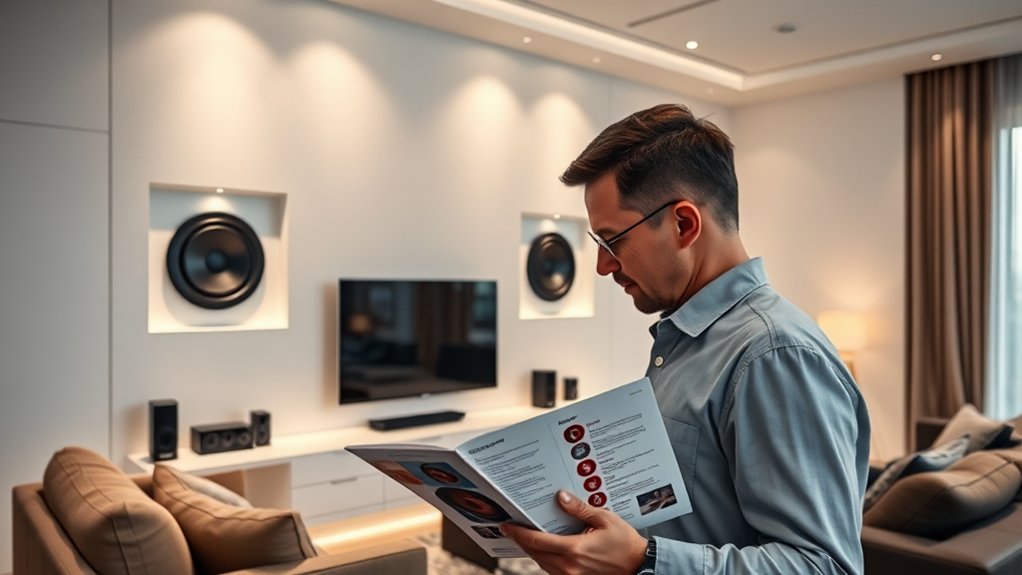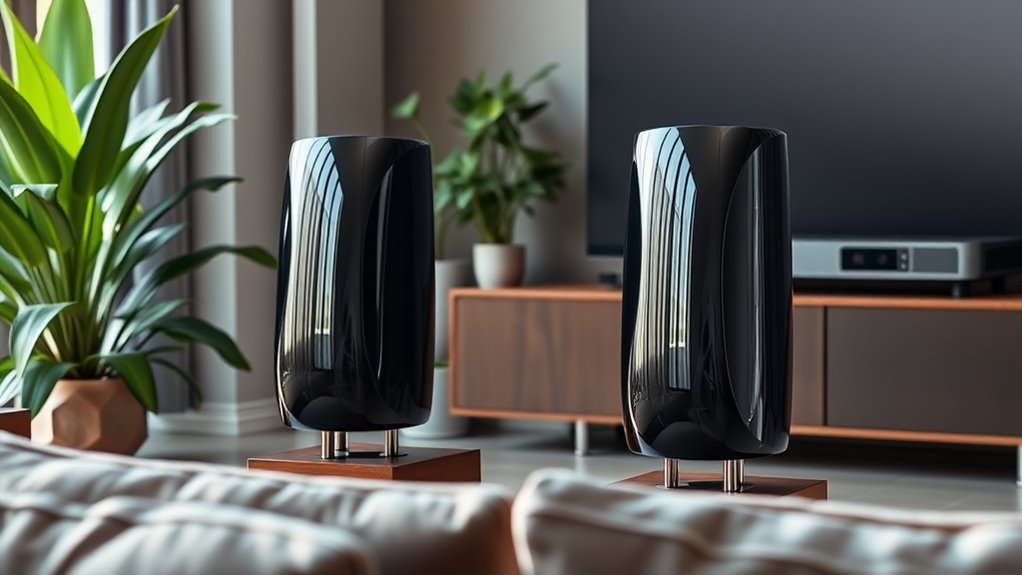For the best home theater experience, focus on speaker placement. Begin by positioning your front speakers at ear height and angled toward your seating area. Your center channel should be right in line with your TV, ensuring clear dialogue. Surround speakers work best at ear level and slightly above, whereas subwoofers can thrive in corners for deeper bass. Remember to leave space from walls to minimize reflections. Curious about other tips and tricks for a stellar setup? There’s much more to investigate!
Key Highlights
- Position front speakers as far apart as their distance from the listening area, angling them inward for optimal sound direction.
- Align the center channel speaker at ear level and flush with the TV edge to enhance dialogue clarity.
- Elevate surround speakers about 2 feet above ear level and angle them toward the listening area for improved focused sound.
- Place the subwoofer in a corner or use the “subwoofer crawl” method to find the ideal bass location in the room.
- Maintain at least 2 to 3 feet distance from walls for speakers to minimize reflections and improve audio clarity.
Optimal Front Speaker Placement
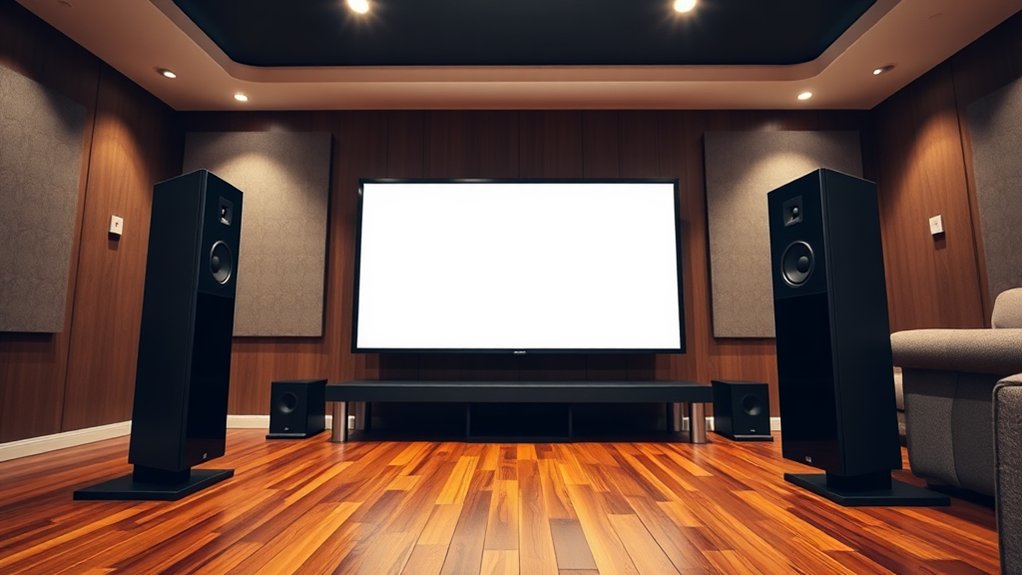
When setting up your home theater, placing your front speakers correctly is critical, as it can greatly improve your audio experience. Aim to space your left and right speakers as far apart as they’re from your main listening position. This setup creates a wide soundstage that bolsters immersion.
To achieve the best clarity, angle the speakers inward slightly, directing sound toward where you sit. Remember, the tweeters should align with your ear height when seated for the best high-frequency response—after all, who wants to miss those subtle details? Additionally, quality speakers and their strategic placement are crucial for delivering a high-quality sound experience.
Position speakers at least a foot away from walls to minimize annoying reflections and muddiness. Room acoustics can also significantly affect speaker placement effectiveness, so consider experimenting with different positions to find what works best for your space. Finally, maintain symmetry in placement for a balanced sound. Your neighbors might just thank you!
Center Channel Speaker Positioning
After your front speakers are in their sweet spots, it’s time to focus on the center channel speaker, which often plays a pivotal role in delivering crisp dialogue and anchoring the sound to what’s happening on screen.
Ideally, you want this speaker at ear level, around 38-42 inches off the floor, either directly below or above your TV. Position it flush with the front edge of the TV to avoid sound obstruction and guarantee no furniture blocks its path. To maximize your viewing experience, ensure the center channel speaker is the major focus of sound mixing, as this will enhance dialog clarity significantly. Proper center channel speaker placement is crucial for achieving high-quality audio through your home theater system. Furthermore, utilizing Dolby Atmos and DTS:X Technologies can elevate the overall sound experience by creating a multidimensional audio environment.
If space is tight, consider angling it toward your ears, which can greatly improve clarity. Remember, a perfectly centered speaker makes it seem like the dialogue is emanating right from the screen—who wouldn’t want that?
Surround Speaker Arrangement

Surround sound is essential for creating an immersive home theater experience, and getting the arrangement of your surround speakers right can greatly improve that sensation.
For a 5.1 system, position your side surround speakers at 90-110 degrees off-axis from your seating, as the rear surrounds in a 7.1 setup should sit at 135-150 degrees. Elevating these speakers about 2 feet above ear level increases clarity and prevents sound shadows. Accurate placement of the surround speakers will significantly enhance clarity and immersion, leading to a much more enjoyable experience as you’ll fully appreciate the immersive audio technologies that modern soundbars offer.
Remember, symmetry is your friend; keep speakers equidistant from sidewalls to avoid confusion. Angle them slightly toward your listening area for focused sound.
After all, who wants to guess where that action’s coming from? Proper placement boosts spatial effects, transforming movie nights into thrilling experiences you won’t forget.
Subwoofer Location Strategies
Finding the perfect spot for your subwoofer isn’t just a matter of convenience; it can truly make or break your home theater experience.
Placing a subwoofer in the corner may seem like it’ll take up space, but it actually improves deep bass thanks to acoustic reinforcement from the walls. If you’ve got two, try positioning them in opposite corners to achieve a balanced frequency response.
Conversely, if you prefer mid-wall positioning, this can offer more direct bass energy.
A handy trick is the “subwoofer crawl”—just place it at your listening position and crawl around the room to find that sweet spot where bass feels just right. It’s simple, yet effective! Additionally, optimal placement near surfaces can enhance the overall audio potential of your sound system.
Acoustic Considerations for Sound Quality
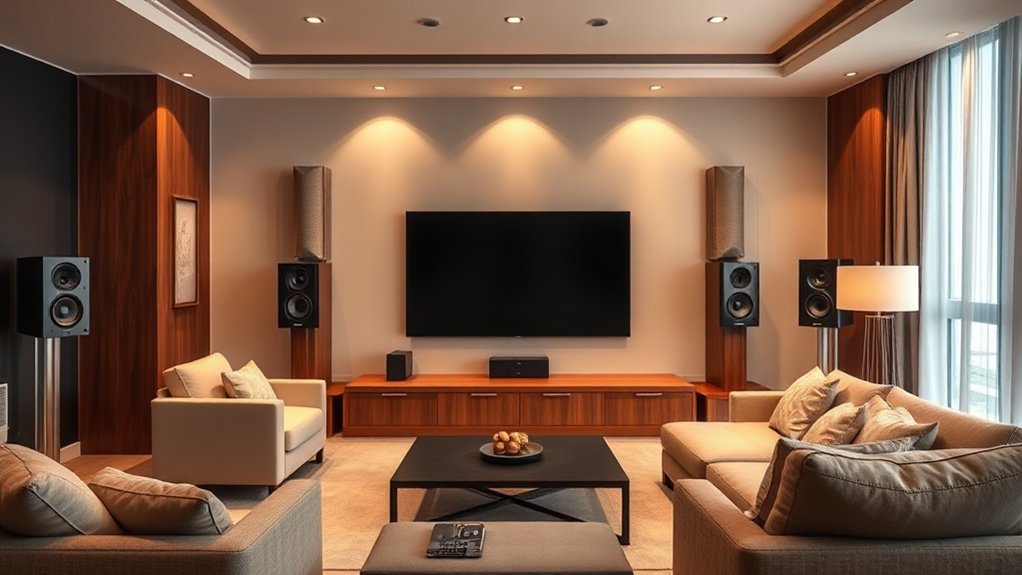
In regards to achieving stellar sound quality in your home theater, understanding the impact of room acoustics is essential.
The shape and size of your room greatly influence how sound waves behave—think of it as making certain your favorite song hits all the right notes. Hard surfaces, like glass and tiles, reflect sound, potentially leading to harshness, whereas soft furnishings, such as carpets or curtains, soften reverberation.
Additionally, parallel walls might create echoes, so opting for non-parallel or angled walls helps disperse sound more evenly. Incorporating acoustic treatments, like bass traps and absorbers, strikes the right balance by controlling reflections and preventing that dreaded audio coloration. Further, ensuring proper speaker positioning can significantly enhance sound clarity and immersion.
After all, who wants to hear the sound bouncing around more than the movie dialog?
Fine-Tuning Speaker Angles
Though optimizing your home theater experience might seem like an intimidating task, getting the angles right for your speakers can greatly improve the overall sound quality.
Start by arranging your main front speakers to form an equilateral triangle with your listening position—think of it as the ultimate audio hug. A slight toe-in of about ¼ to ½ inch can focus the sound, ensuring that tweeters aim directly at your ears for clarity.
For surround speakers, angling them inward creates that immersive wraparound effect—after all, who wouldn’t want to feel like they’re inside the action?
Finally, don’t forget to adjust incrementally; fine-tuning speaker angles is often a game of trial and error. Additionally, consider the advantages of excellent sound quality that systems like the LG SJ2 provide. So, are you ready to plunge into a better soundscape?
Adjusting Height for Clarity
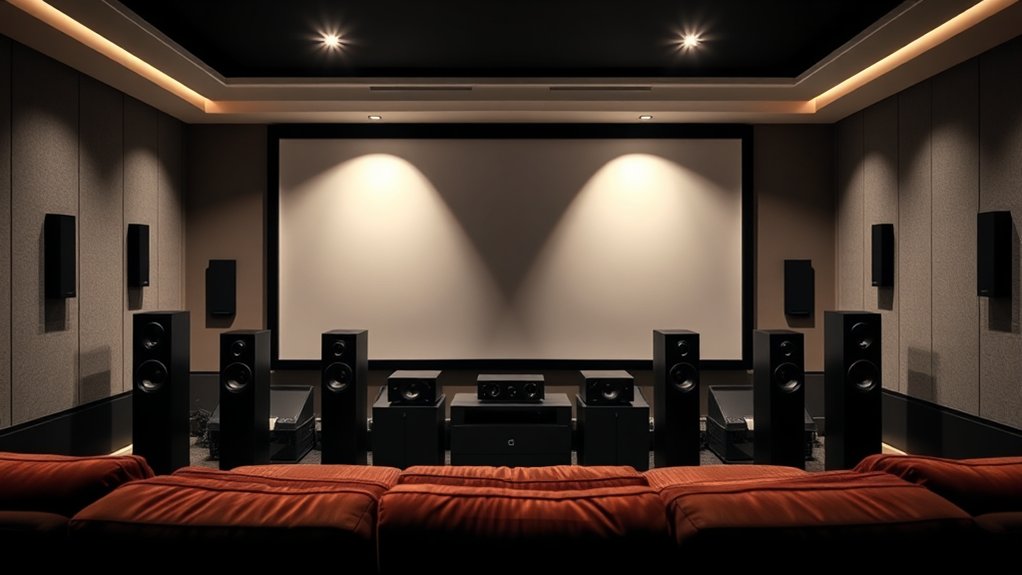
When you’ve fine-tuned those speaker angles for ideal sound, it’s time to focus on height—namely, adjusting your speakers to achieve the clearest audio.
Aim to place your front height speakers at about 30 degrees from your center-front position; this keeps sound projection effective. If you’re mounting them on the ceiling, placing them within 45 degrees vertical guarantees they’re too far from the ear-level speakers, avoiding muddled sound.
Remember, good speaker placement can mean the difference between crisp dialogue and a confusing mix of sounds. Tweeter drivers should hit your ear level for precision, whereas those height speakers need to soar above that for immersive effects. The addition of 5.1 surround sound enhances the overall audio experience, providing clarity for immersive listening.
After all, who wants to miss dialogue just due to speaker height?
Experimenting With Distance From Walls
Finding the right distance between your speakers and the walls can greatly improve your home theater experience, especially since slight adjustments can make a world of difference in audio quality.
Aim to position your speakers at least 2 to 3 feet from the nearest walls; this minimizes unwanted sound reflections that could muddy your audio. If you’ve got rear-facing bass ports, give them even more space to avoid bass confusion.
Experiment with moving front speakers away from the front wall—it can eliminate that bothersome bass boominess. Remember, the proximity of side walls matters too; keeping your speakers 1 to 2 feet away helps maintain stereo imaging.
Utilizing Multiple Subwoofers
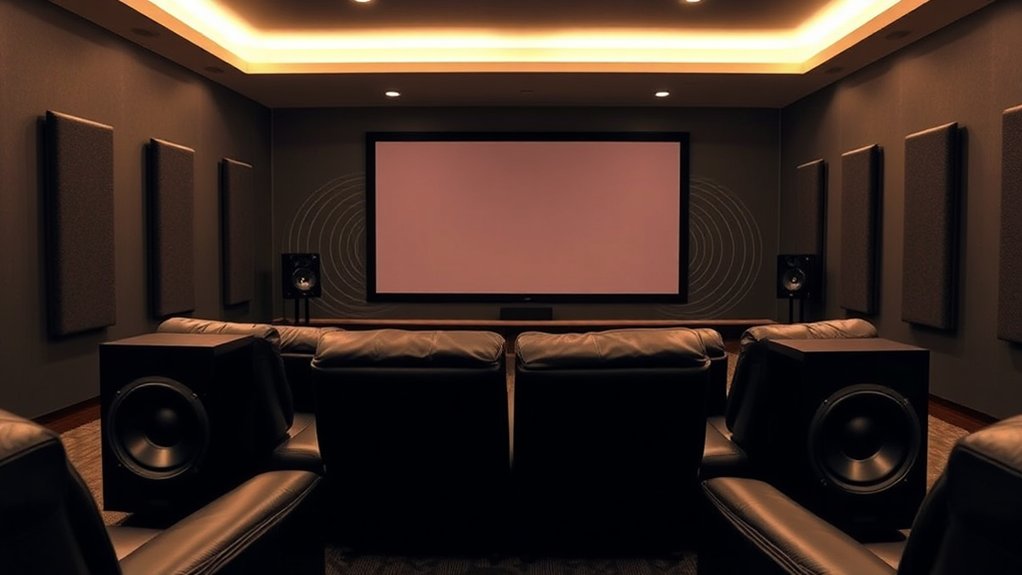
Getting your speaker placement just right is a fantastic start, but to truly amp up your home theater experience, you might want to contemplate utilizing multiple subwoofers.
By adding two or more subs, you can smooth out bass frequencies across your entire listening area, effectively reducing those annoying peaks and nulls that often plague single-sub setups.
Imagine enveloping yourself in deep, rich bass that seems to come from all around rather than one distinct corner—it’s like having a concert in your living room!
Plus, smaller subs are easier to tuck away, making your space look great while still delivering powerful sound.
Just think about how much more immersive your movie nights could be—who wouldn’t want that? Additionally, integrating multiple subwoofers can enhance the 3D soundscape you experience, providing a more enveloping auditory environment.
Regular Reassessment of Speaker Layout
To guarantee your home theater delivers the best sound experience possible, regularly reassessing your speaker layout is essential—even if you think everything’s just fine.
Room acoustics can shift over time because of furniture changes or new decor, and even minor tweaks in placement can dramatically improve dialogue clarity and overall sound quality.
Room acoustics evolve with your space, and minor adjustments can significantly enhance sound clarity and quality.
Think of it as a fine-tuning process: every adjustment you make helps maintain that ideal soundstage.
For instance, confirm your front speakers remain at the correct angles to your seating, as well as checking that the center speaker is aligned with your ear level.
And don’t forget to recalibrate after adding new components!
After all, who doesn’t want their movie nights to sound just right?
Frequently Asked Questions
Can Furniture Placement Affect Speaker Performance and Sound Quality?
Yes, furniture placement can greatly affect speaker performance and sound quality. Positioning furniture too close can obstruct sound waves, whereas reflective surfaces might create undesirable echoes, distorting clarity. Thoughtful arrangement optimizes your audio experience.
How Do Room Dimensions Impact Speaker Placement Strategy?
Room dimensions greatly impact your speaker placement strategy. In smaller rooms, you’ll need to simplify configurations, whereas larger spaces allow for more elaborate setups. Adjust distances and consider shape effects for ideal sound quality and balance.
Should I Prioritize Aesthetics Over Acoustics When Placing Speakers?
You shouldn’t prioritize aesthetics over acoustics when placing speakers. Although design matters, ideal speaker positioning greatly improves sound quality. Striking a balance is essential, but sound clarity and immersion should take precedence.
What Is the Ideal Distance Between My Listening Position and Speakers?
To achieve balanced sound, you should place your listening position about 1 to 1.2 times the distance between your speakers. This setup improves stereo imaging and guarantees clear audio without dead spots. Adjust for room asymmetry as needed.
How Does Speaker Wire Length Affect Sound Quality?
Speaker wire length affects sound quality by increasing resistance, which can reduce power delivery and alter frequency response. Longer runs may additionally expose you to interference, leading to slightly diminished audio clarity and fidelity in your setup.


